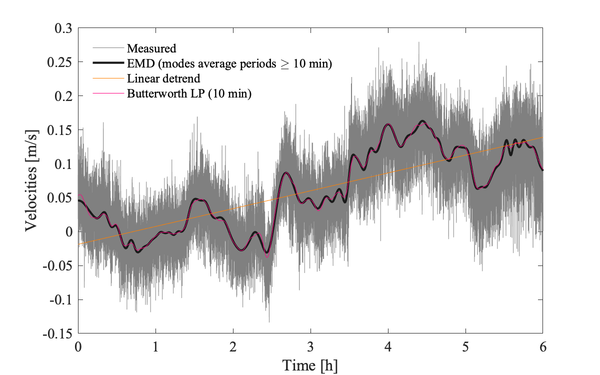Decomposing velocity measurements: Difference between revisions
mNo edit summary |
|||
| Line 6: | Line 6: | ||
The quality-controlled velocities are first [[Detrending time series|detrended]] before being further analysed to determine [[Velocity past the sensor|mean flow past the sensor]] and [[Surface wave statistics|surface wave statistics]]. These quantities are necessary for later choosing the appropriate [[Velocity inertial subrange model| inertial subrange model]] for [[Spectral fitting|spectral fitting]]. | The quality-controlled velocities are first [[Detrending time series|detrended]] before being further analysed to determine [[Velocity past the sensor|mean flow past the sensor]] and [[Surface wave statistics|surface wave statistics]]. These quantities are necessary for later choosing the appropriate [[Velocity inertial subrange model| inertial subrange model]] for [[Spectral fitting|spectral fitting]]. | ||
== | ==Methods for detrending== | ||
This step involves separating the [[quality-controlled Data processing of raw measurements| raw velocities]] into: | This step involves separating the [[quality-controlled Data processing of raw measurements| raw velocities]] into: | ||
* low-frequency component comprising of the background large-scale flow | * low-frequency component comprising of the background large-scale flow | ||
* high-frequency component | * high-frequency component consisting of turbulence, surface wave signals, and unwanted contamination such as wakes and vibrations associated with the frame or measurement noise. | ||
[[File:Long timeseries.png|thumb|none|600px|Measured velocities at 4 Hz from an [[Acoustic-Doppler Velocimeters]] have been detrended using three different techniques. Empirical modal decomposition (EMD) <ref name="Wuetal_PNAS">{{Cite journal | |||
|authors=Zhaohua Wu, Norden E. Huang, Steven R. Long, and Chung-Kang Peng | |||
|journal_or_publisher=PNAS | |||
|paper_or_booktitle=On the trend, detrending, and variability of nonlinear and nonstationary time series | |||
|year=2007 | |||
|doi=10.1073/pnas.0701020104 | |||
}}</ref>, linear trend, and a 2nd order low-pass Butterworth filter. A cut-off period of 10 min was targeted by both the filter and EMD]] | |||
==Methods for decomposing== | ==Methods for decomposing== | ||
Revision as of 17:56, 29 November 2021
{{#default_form:Processing}}
{{#arraymap:
Velocity point-measurements
|,|x||}}
{{#arraymap:level 2 segmented and quality controlled|,|x||}}
The quality-controlled velocities are first detrended before being further analysed to determine mean flow past the sensor and surface wave statistics. These quantities are necessary for later choosing the appropriate inertial subrange model for spectral fitting.
Methods for detrending
This step involves separating the raw velocities into:
- low-frequency component comprising of the background large-scale flow
- high-frequency component consisting of turbulence, surface wave signals, and unwanted contamination such as wakes and vibrations associated with the frame or measurement noise.

Methods for decomposing
Long continuous sampling
Different techniques dependent on whether measurements were collected continuously or in long bursts (define here). The high-frequency content can be obtained by:
- High-pass filtering (linear and stationary signals)
- Empirical mode decomposition (nonlinear and/or non-stationary signal)
Short burst sampling
A short burst is typically at most 2-3x the expected largest turbulence length scales. As a rule of thumb, turbulence estimates from the inertial subrange of velocity rely on 5 to 15 min long-segments.
- Remove the arithmetic mean of the burst to obtain the high-frequency content
- Linear trend removal
- Empirical mode decomposition (nonlinear and/or non-stationary signal)
Return to Velocity point-measurements' welcome page
- ↑ {{#arraymap:Zhaohua Wu, Norden E. Huang, Steven R. Long, and Chung-Kang Peng|,|x|x|, |and}}. 2007. On the trend, detrending, and variability of nonlinear and nonstationary time series. PNAS. doi:10.1073/pnas.0701020104
